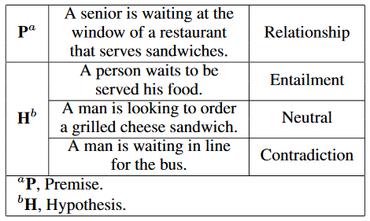Natural Language Inference
730 papers with code • 43 benchmarks • 77 datasets
Natural language inference (NLI) is the task of determining whether a "hypothesis" is true (entailment), false (contradiction), or undetermined (neutral) given a "premise".
Example:
| Premise | Label | Hypothesis |
|---|---|---|
| A man inspects the uniform of a figure in some East Asian country. | contradiction | The man is sleeping. |
| An older and younger man smiling. | neutral | Two men are smiling and laughing at the cats playing on the floor. |
| A soccer game with multiple males playing. | entailment | Some men are playing a sport. |
Approaches used for NLI include earlier symbolic and statistical approaches to more recent deep learning approaches. Benchmark datasets used for NLI include SNLI, MultiNLI, SciTail, among others. You can get hands-on practice on the SNLI task by following this d2l.ai chapter.
Further readings:
Libraries
Use these libraries to find Natural Language Inference models and implementationsLatest papers with no code
Automated Long Answer Grading with RiceChem Dataset
With this work, we offer a fresh perspective on grading long, fact-based answers and introduce a new dataset to stimulate further research in this important area.
Marking: Visual Grading with Highlighting Errors and Annotating Missing Bits
We subsequently train language models to identify entailment, contradiction, and neutrality from student response, akin to NLI, and with the added dimension of identifying omissions from gold answers.
Explanation based Bias Decoupling Regularization for Natural Language Inference
The robustness of Transformer-based Natural Language Inference encoders is frequently compromised as they tend to rely more on dataset biases than on the intended task-relevant features.
How often are errors in natural language reasoning due to paraphrastic variability?
We propose a metric for evaluating the paraphrastic consistency of natural language reasoning models based on the probability of a model achieving the same correctness on two paraphrases of the same problem.
DKE-Research at SemEval-2024 Task 2: Incorporating Data Augmentation with Generative Models and Biomedical Knowledge to Enhance Inference Robustness
Safe and reliable natural language inference is critical for extracting insights from clinical trial reports but poses challenges due to biases in large pre-trained language models.
MSciNLI: A Diverse Benchmark for Scientific Natural Language Inference
Furthermore, we show that domain shift degrades the performance of scientific NLI models which demonstrates the diverse characteristics of different domains in our dataset.
SemEval-2024 Task 2: Safe Biomedical Natural Language Inference for Clinical Trials
Addressing this, we present SemEval-2024 Task 2: Safe Biomedical Natural Language Inference for ClinicalTrials.
A Morphology-Based Investigation of Positional Encodings
How does the importance of positional encoding in pre-trained language models (PLMs) vary across languages with different morphological complexity?
SEME at SemEval-2024 Task 2: Comparing Masked and Generative Language Models on Natural Language Inference for Clinical Trials
This paper describes our submission to Task 2 of SemEval-2024: Safe Biomedical Natural Language Inference for Clinical Trials.
A Differentiable Integer Linear Programming Solver for Explanation-Based Natural Language Inference
Integer Linear Programming (ILP) has been proposed as a formalism for encoding precise structural and semantic constraints for Natural Language Inference (NLI).
































 GLUE
GLUE
 MultiNLI
MultiNLI
 SNLI
SNLI
 QNLI
QNLI
 MRPC
MRPC
 WinoGrande
WinoGrande
 XNLI
XNLI
 SICK
SICK
 ANLI
ANLI
 PAWS
PAWS

